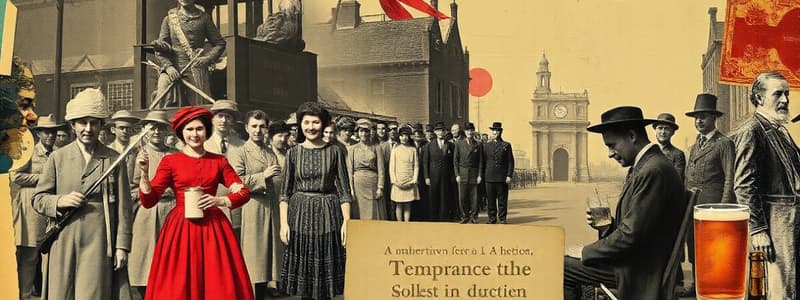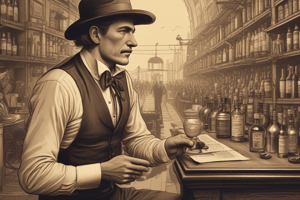Podcast
Questions and Answers
What was the primary goal of the temperance movement?
What was the primary goal of the temperance movement?
- To increase alcohol production for economic growth.
- To promote the consumption of beer and wine over liquor.
- To restrict or abolish the consumption of alcohol. (correct)
- To regulate the sale of alcohol to minors only.
Which amendment to the U.S. Constitution was a success for the temperance movement?
Which amendment to the U.S. Constitution was a success for the temperance movement?
- The Twenty-First Amendment
- The Twenty-Sixth Amendment
- The Nineteenth Amendment
- The Eighteenth Amendment (correct)
Which of the following is the definition of "teetotalism"?
Which of the following is the definition of "teetotalism"?
- Moderate consumption of alcohol
- Drinking only beer and wine
- Total abstinence from alcohol (correct)
- Promoting the use of alcohol in small amounts for health benefits
Which organization was founded in Cleveland, Ohio in 1874 to promote temperance and social reform?
Which organization was founded in Cleveland, Ohio in 1874 to promote temperance and social reform?
What was the name of the Act passed by Congress that was a success of the Temperance movement?
What was the name of the Act passed by Congress that was a success of the Temperance movement?
Flashcards
Temperance Movement
Temperance Movement
A social movement in the U.S. aiming to restrict or abolish alcohol consumption, culminating in the Eighteenth Amendment.
Teetotalism
Teetotalism
The practice of complete abstinence from alcohol, promoted as the best solution by temperance activists.
Women's Christian Temperance Union (WCTU)
Women's Christian Temperance Union (WCTU)
An organization founded in 1874 that connected temperance with Christian virtues and sought political solutions.
Anti-Saloon League (ASL)
Anti-Saloon League (ASL)
Signup and view all the flashcards
Volstead Act/Eighteenth Amendment
Volstead Act/Eighteenth Amendment
Signup and view all the flashcards
Study Notes
Overview of the Temperance Movement
- A social movement in the U.S. during the 19th and early 20th centuries, aiming to restrict or abolish alcohol consumption.
- Achieved federal success during the Progressive Era with the Eighteenth Amendment.
- Initially favored beer and wine over liquor due to lower alcohol content.
- Later advocated for teetotalism (complete abstinence) as alcohol-related problems grew.
- Sought to eradicate the negative impacts of alcohol on society, families, and individuals.
- Promoted prohibition as a political solution and temperance as an individual solution.
- Engaged in protests and social/educational reforms due to slow adoption of their solutions.
History and Timeline
- Earliest organizations emerged around 1810, though abstinence pledges were in Protestant churches since 1800.
- By the mid-1830s, about 6,000 temperance organizations existed nationwide.
- 1800: Churches started abstinence pledges.
- 1808: First temperance organization created in Saratoga, New York.
- 1813: Temperance organization formed in Massachusetts.
- 1826: American Temperance Society formed, connecting temperance with religious purity.
- 1851: Order of Good Templars, the world's first international temperance organization, was created
- 1869: Prohibition Party founded, one of the first to admit women.
- 1874: Women's Christian Temperance Union (WCTU) founded in Cleveland, Ohio.
- 1883: World's Woman's Christian Temperance Union formed
- 1893: Anti-Saloon League founded in Ohio.
- 1895: Anti-Saloon League becomes a national organization.
- 1909: First world prohibition conference in London establishes the International Prohibition Confederation
- 1917-18: Volstead Act/Eighteenth Amendment passed by Congress.
- 1919: Eighteenth Amendment ratified.
Causes and Influences
- Members believed alcohol destroyed individuals and families, with factory workers being significantly affected.
- Employers were concerned about intoxication increasing safety issues and decreasing productivity.
- Many organizations, largely composed of women, also advocated for issues like women's suffrage.
- Heavily influenced by Protestant Christianity, emphasizing societal betterment.
- Christian-based movements, like the Women's Christian Temperance Union, spread more successfully than secular ones.
- The Second Great Awakening revitalized Christian feeling, seeking to purge society of evils like alcohol.
Key Groups and Organizations
- Protestant groups in rural areas were primary supporters.
- Other entities include:
- American Temperance Society
- Women's Christian Temperance Union
- Anti-Saloon League
- Business owners
- Methodist religious movement
- The movement grew significantly after the 1860s and became increasingly political.
- Activists used songs, media, pamphlets, and sermons to promote their cause.
Successes and Impact
- Achieved local success with state laws promoting temperance in the 19th century.
- Reached the federal level with the Volstead Act and the Eighteenth Amendment around 1920.
- The Eighteenth Amendment lasted for sixteen years until repealed by the Twenty-first Amendment.
Key Leaders and Organizations
- Leaders included Carrie Nation, Frances Willard, Howard Hyde Russell, and Wayne Wheeler.
Women's Christian Temperance Union (WCTU)
- Founded in 1874 in Cleveland, Ohio, to promote temperance and societal reform.
- Connected temperance with Christian virtues and sought political solutions.
- Francis Willard, the second president, expanded the WCTU's efforts to include legal and political actions.
- Willard's priorities included women's rights, suffrage, and social reform.
- In 1889, Willard became the first president of the National Council of Women.
Anti-Saloon League
- A modern lobbying group founded mostly by men.
- Focused solely on prohibition, unlike the WCTU.
- William Anderson was a prominent lobbyist.
- Howard Hyde Russell, a minister, founded the league through his Christian network.
- Wayne Wheeler used "pressure politics" to convince politicians to enforce prohibition.
- He inundated the legal system with alcohol-related lawsuits.
Political Significance and Impact
- The passage of the Volstead Act and the Eighteenth Amendment to the Constitution was the most obvious effect.
- The prominence of women activists diminished as men's temperance organizations were created.
- The creation of women’s suffrage was postponed, but it was still a prominent debate subject.
Societal Significance and Impact
- There was a significant association of temperance with the fundamentalist Christian movement.
- Temperance education was connected to harmful racial stereotypes and misinformation.
- Extremism rose as political and societal reforms failed, causing resentment toward members.
Studying That Suits You
Use AI to generate personalized quizzes and flashcards to suit your learning preferences.




